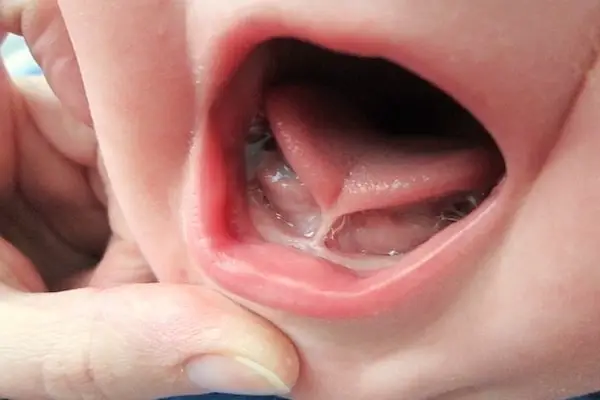Welcome to Completely Aligned, where we explore the intricate world of tongue tie in infants. As an experienced lactation consultant (IBCLC) and Advanced Pediatric Osteopath, I’ve witnessed firsthand the vital role that a thorough oral assessment plays in identifying tongue tie in newborns, children, and even adults. Tongue tie, medically known as ankyloglossia, refers to a condition where the frenulum, a small band of tissue connecting the tongue to the floor of the mouth, is either too short or too tight, thus limiting the tongue’s mobility. This limitation can manifest in various ways, most commonly affecting tongue protrusion, lateralization, and elevation. In this article, we will explore the telltale signs of tongue tie and underscore the importance of early oral assessments in the days following childbirth.
Recognizing the Signs of Tongue Tie in Newborns
Difficulty Latching: Tongue-tied infants often struggle to open their mouths wide enough to latch onto the breast effectively, causing frustration for both mother and baby.
Poor Weight Gain: Tongue-tied infants may have difficulty transferring milk from the breast, resulting in inadequate weight gain. To ensure your baby’s well-being, close monitoring of their weight is crucial. If concerns arise, seeking an oral assessment from a qualified health professional with specialized training in oral ties is essential. It’s worth noting that poor weight gain isn’t exclusive to babies with oral ties, as it can also occur in cases of maternal oversupply. This further underscores the need for comprehensive assessments that encompass both baby and mother’s visual and functional aspects, along with a thorough breastfeeding/feeding evaluation.
Clicking or Smacking Noises: While nursing, babies with tongue tie may produce clicking or smacking sounds due to inadequate tongue mobility.
Fussy or Colicky Behavior: Frequent detachment and air intake during feeds can cause discomfort and fussiness in tongue-tied infants.
Nipple Pain or Damage: Mothers may experience nipple pain and damage due to shallow latching caused by tongue tie.
The Importance of Early Comprehensive Oral Assessments
Conducting a thorough oral assessment in the days following childbirth holds significant benefits:
Prevention of Breastfeeding Problems: Early identification of tongue tie can help prevent breastfeeding challenges. Lactation consultants can collaborate with mothers and babies to develop strategies to overcome these difficulties stemming from tongue tie.
Enhanced Milk Transfer and Weight Gain: Early treatment can improve your baby’s ability to transfer milk effectively from the breast, ultimately promoting better weight gain.
Reduced Pain and Discomfort for the Mother: Treating tongue tie can alleviate nipple pain and damage experienced by mothers, offering them much-needed relief.
Enhanced Quality of Life for the Baby and Family: Tongue-tied babies may experience fussiness or colic, which can affect both the baby and the family’s overall quality of life. Addressing tongue tie can improve the baby’s feeding experience, resulting in a happier and healthier family and a prolonged duration of breastfeeding.
It’s crucial to consult a healthcare provider well-versed in tongue tie and its impact on breastfeeding for a proper assessment.
I strongly recommend that mothers have their baby’s oral anatomy evaluated early on to identify potential tongue tie issues. By doing so, we can ensure that babies can breastfeed effectively, leading to a joyful and healthy breastfeeding journey for both mother and baby.
For more information, please don’t hesitate to call us at 02 4655 5588.
At Completely Aligned, our team of Lactation Consultants and Osteopaths have undergone extensive training and observations with Dr. Reena Murray to provide comprehensive assessments for Oral Ties. If indicated, we can refer you to our network of providers across Sydney for release procedures. Our Lactation Consultants and Osteopaths work closely with families post-release to support feeding and alleviate any remaining tension from oral ties through bodywork. For further reading on Oral Ties, we recommend visiting Dr. Bobby Ghaheri’s ENT website.
References:
Kotlow, L. A. (2021). Diagnosis and Treatment of Ankyloglossia in Infants with Breastfeeding Difficulties. Journal of Human Lactation, 37(1), 9-20.
Coryllos E, Watson Genna C, Salloum AC. (2004) Congenital Tongue-tie and its Impact on Breastfeeding. American Academy of Pediatrics. Summer Newsletter Section on Breastfeeding p1-6.
Ingram J, Johnson D, Copeland M, Churchill C, Taylor H, Emond A. (2015) The Development of a Tongue-tie Assessment Tool to Assist with Tongue-tie Identification. BMJ.
Siegel, S. (2016). Aerophagia Induced Reflux in Breastfeeding Infants With Ankyloglossia and Shortened Maxillary Labial Frenula (Tongue and Lip Tie). International Journal Of Clinical Pediatrics, 5(1), 6-8.








